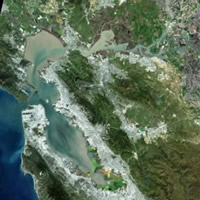
Today the Bay has distinguishing characteristics of a drowned valley. The shoreline is highly irregular and is bordered by tidal marshes. Cliff erosion is slight, and there are few sandy or pebbly beaches. Most of the Bay is shallow, being less than 18 feet deep. Eighty-five percent of the Bay is less than 30 feet deep. The Bay consists of several deep channels, which mark the courses of the principal streams that flowed through the valley before it was drowned. Today the tides flow through these channels, keeping them fairly free of sediment. But how did the Bay get like this?
Beginning in the late Miocene and early Pliocene epoch (between 11 and 16 million years ago), there existed an "ancestral" San Francisco Bay. It stretched from somewhere near the present day Monterey Bay to just beyond Suisun Bay. The western edge was near the site of today's Berkeley Hills and the eastern edge is unknown.
The seaway was warm and shallow. The bottom was irregular. The connection to the sea was restricted. The waterline varied as the climate varied and the land rose and subsided due to earth movements. As the sea level fluctuated, marshes or even mollusk beds might replace a shoreline forest. At the water's edge grew Swamp Cypress and Tupelo. Further inland stood the border forest of Red Bay, Sycamore, Willow, Birch, Chumico and Magnolia. Not much is known about the land animals of this time.
After the river cut a gorge at Carquinez, it followed a course through what is now San Pablo Bay, eroding a channel south of Angel Island and joined the southern drainage. Together the streams must have breached the last barrier to the sea at the Golden Gate. A great alluvial fan began to develop there.
The Bay might never have developed beyond this point if an inexplicable thing hadn't happened. The climate changed. Perhaps 225,000 years ago, the glaciers began to recede all over the world. The streams began to fill. The rise in sea level was unyielding. The sea nibbled at the Golden Gate delta, creeping slowly through the gate, drowning gorges and valleys and created tidal marshes. Plants and animals of the dry lands were driven back, to be replaced by new species. By about 100,000 BCE, the Bay was nearly the maximum size it would reach. Then the weather cooled again. The waters of the sea retreated and the glaciers advanced. By 25,000 BCE, another thaw began, and by 10,000 BCE the Bay had attained its maximum size.